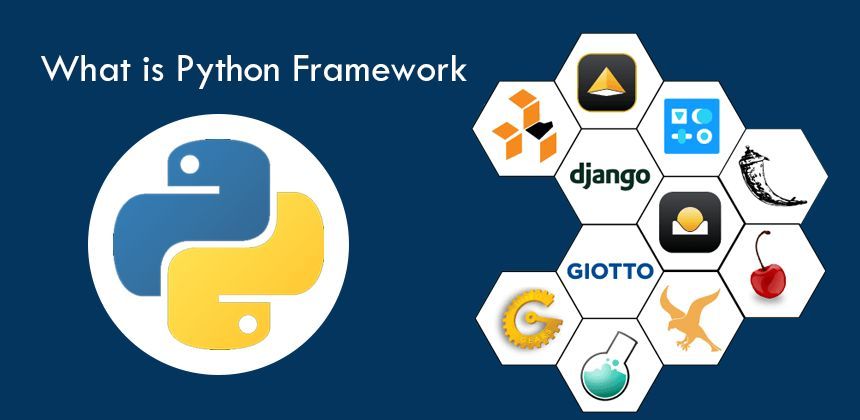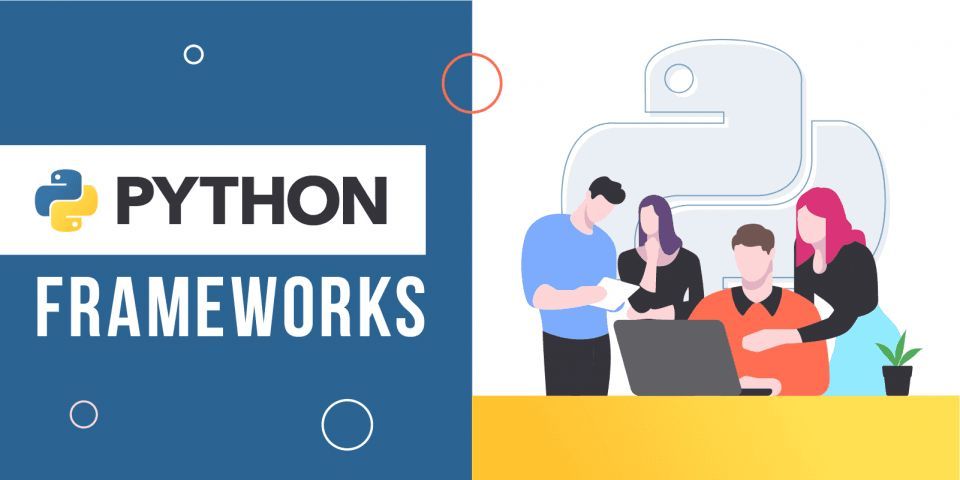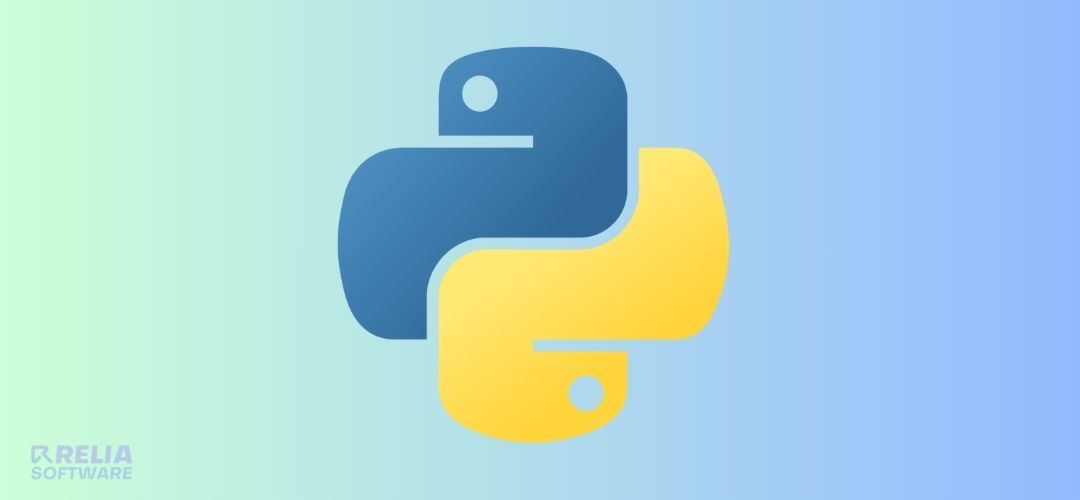A Python framework is a set of modules with common functionality that may be used to build any application. Frameworks provide a broad guideline for building software and abstract away complex or repetitive processes to simplify development. This lets you write your own application logic instead of reinventing the wheel. Let's look at Python frameworks in this article.
>> Read more:
- What is Python? Unveiling the Power of Python
- Why Should You Focus On Python For Machine Learning?
What Is A Python Framework?
A Python framework is a group of Python modules that work together to provide a common set of features that can be used to make any kind of application.
Frameworks are meant to make the process of making software easier by giving us a general idea of how to do it and hiding some of the more difficult or repetitive tasks. Because of this, you can focus on writing unique logic for your apps instead of having to start from scratch.
One job that you do over and over is responding to HTTP requests. Developers don't have to write everything from scratch or use the same code for multiple projects because most web apps need to handle this type of request. Instead, they use tools that make this possible.

3 Types of Python Frameworks
Full-Stack Framework
Full-stack Python frameworks give developers everything they need to build a web project. This type of framework, as the name suggests, has everything you need to build a website, including a form the generator, form validation, template styles, and more. You can use this kind of framework for any kind of program. It is a bit hard to understand how to use.
The backend offers standard functions like creating records in the database, managing HTTP requests, and managing application security, and the frontend includes templates and a mechanism to present information to users.
Microframework
Microframeworks are lightweight frameworks that give only the basic components for building applications. This is a simple, light framework that doesn't offer any extra features like a data abstraction layer, form validation, or so on. To add new features and functions, developers have to put in a lot of work by writing code by hand. This is helpful for little tasks.
It's lightweight and extensible, making it ideal for small applications or developers that desire more code control.
Asynchronous Frameworks
Asynchronous frameworks handle parallelism and concurrency, enabling developers to build multitasking apps. This platform is becoming more common, and it works with the asyncio library. This type of framework is mostly useful for managing a lot of links at the same time.
Benefits of Using A Python Framework
When making apps, using a Python framework can be helpful in a number of ways. Let's go over a few of them:
-
Frameworks make it easy for your software developer to do their job: Frameworks can make it easier and faster for developers to make apps by giving the code a structure and giving developers a set of tools and features that speed up the development process.
-
Frameworks help keep code organized: A well-designed framework keeps the code organized and stable, which makes it easier to read and change the source code in the future.
-
Frameworks can help people get more done: Frameworks let developers focus on the unique parts of their apps instead of doing boring tasks because they come with pre-built parts and tools that follow industry norms.
>> Read more:
Top 15 Best Frameworks You Should Consider

Django
This is the most popular full-stack Python framework, ranking in the top five web frameworks. It is open source to use, with many features that make web building much simpler.
It aids in the development and delivery of highly scalable, quick, and resilient online applications. It includes extensive documentation as well as community assistance. In addition, it comes with pre-installed packages and modules that are ready to use.
It also has URL filtering, database versioning, schema transformations, authorization, web server compatibility, a template processor, and an ORM.
Key features:
-
Very safe structure;
-
Admin screen built in;
-
Own template language that shows HTML object-relational-mapper (ORM) automatically, set up the database with Python classes;
-
Using the Python API to query databases;
-
Excellent CLI tools;
-
A lot of different extensions.
Flask
Flask is among the most popular Python platforms for web design. It’s a straightforward framework with a large number of add-ons. It can provide a basic API to a remote server fast. It includes, among some other things, a built-in debugger, HTTP request processing, an in-built testing host, system testing assistance, and RESTful response handling.
It now provides recommendations rather than imposing any prerequisites, and it has enhanced and secured functionality for cookies for creating client-side identities. Flask is renowned for its speed of installation; it may be up and operating in seconds. Flask is the 11th commonly utilized framework in website development businesses, behind only Django by 14.2%.
>> Read more: Django vs. Flask in 2023: Which Framework to Choose
Key features:
-
Easy to use and not heavy;
-
A lot of freedom;
-
Built on top of the core package for Python;
-
Help with routing and views (controllers);
-
Jinja templates can be used with support;
-
Very good group and documentation;
-
Help for dealing with cookies and authentication for users.
Pyramid
Pyramid is a light web framework reproduced in Python 2 and 3. It’s intended to make building web apps a lot simpler. However, the pyramid only includes the essential tools for almost all web applications, such as translating URLs to script, safety, and delivering static resources, such as JavaScript or CSS files.
Pyramid promotes conventional Python development methods with package capabilities, virtual worlds, monitoring, and other features. Pyramid’s fame is steadily increasing. The majority of seasoned developers are enthusiastic about it.
Pyramid frameworks are adaptable, and they may be utilized for both simple and complex applications. Because of its openness and measurable quality, it is the most well-regarded web framework among seasoned software engineers. Firefox, Dropbox, and SurveyMonkey are among the companies that have utilized them.
Key features:
-
Easy to bend and light;
-
Support for the Mako template language Makes it easy to set up authentication and permission;
-
WSGI-compliant objects for requests and responses;
-
Easy debugging and testing with a debugger that you can work with and built-in testing helpers;
-
Third-party apps and libraries that are easy to add.
CherryPy
CherryPy, which is nearly ten years old, is very fast and reliable. It’s a free Python website development kit that has its multi-hung client built-in. It may be executed on any Python-compatible framework.
One may use any type of technology for accessing data, scripting, and so on with a modest web application framework. So, yes, it can handle everything a web application framework can, such as transactions, document management, static content, cookies, and so on.
CherryPy allows programmers to create web applications in the same way they have every other object-oriented Python script. As a consequence, lesser source code is developed in less time.
Key features:
-
Flexible and expandable method for adding plugins;
-
Only for the backend;
-
Developing with objects;
-
API that is stable;
TurboGears
TurboGears is indeed a comprehensive Python web framework, similar to Python systems like Django. It includes many components and modules that integrate the most delicate features of existing Python web application architectures.
Multi-database compatibility, MVC design, Pylon as a central server, PasteScript themes, command-line utilities, and other advanced features are included in the framework. TurboGears is a popular Python website framework because of its versatility and reuse of snippets.
Key features:
-
All of the features are built as function wrappers;
-
Command-line tools that are available;
-
Adding the MochiKit JavaScript library;
-
Help for multiple databases;
-
Architecture in the MVC style;
-
Templates for PasteScript;
-
ToscaWidgets to make it easier to coordinate designing the front end and deploying the server;
-
Its computer server is Pylons;
-
FormEncode lets you validate data.
Web2Py
This is a complete python-based programming language that rapidly creates massively efficient, safe, and transportable database-driven web-based programs. It is open-source and thus free. This platform effectively integrates the python development process via a remote server, a SQL database, and an online frontend.
Clients may also use an internet browser to create, organize, administer, and launch web-based applications. If anything unexpected happens, it includes a built-in mechanism for handing out tickets.
Web2Py is flexible, which means it is backward compatible, and it has a substantial population behind it. Extra features include built-in information security, adaptable Mvc design compliance, defined data protection, data privacy, and role-based authentication.
Key features:
-
It can run on any web server that supports Python or Java, and Python;
-
Compatibility with the past;
-
Built-in data security to stop a number of common security holes, such as remote scripting, injection flaws, and harmful file execution;
-
Without the need for installation and setup;
-
Follows the MVC design and helps with internationalization;
-
Readability of more than one system;
-
Controlling access based on roles;
CubicWeb
It’s a conceptual Python web app foundation that’s free to use under the LGPL license. This framework aids programmers in the creation of web applications by repurposing components known as cubes. In addition, it uses an object-oriented architecture, which makes the code more rapid and debuggable.
RQL (Relational Query Language) integration facilitates data-related inquiries by providing a concise syntax for connection inquiries, managing data libraries, and seeing characteristics and associations.
Semi-automatic methods for XHTML/XML/JSON/text creation, security processes and Web Ontology Framework, LDAP domains, and memory backend dependability are among the other characteristics.
Key features:
-
You can use OWL (Web Ontology Language) and RDF (Resource Description Framework);
-
Using-again parts;
-
Workflows for security;
-
Uses RQL (Relational Query Language) encoding to make data searches easier;
-
Support for more than one database.
Bottle
Want to make web apps that are incredibly light and don't depend on anything else? Bottle is a small, lightweight Python platform that makes it easy to create small to medium-sized web apps. Aside from the Python standard library, it doesn't rely on any other libraries.
Bottle is built on top of the WSGI standard, which means it works with most web hosts and versions of Python.
Key features:
-
Simple to understand and use;
-
Built-in method for templates;
-
Makes it possible to create small web apps and APIs;
-
Very little memory use;
-
Help with HTTP, forms, and routes.
Fast API
Want to make web apps that are incredibly light and don't depend on anything else? Bottle is a small, lightweight Python platform that makes it easy to create small to medium-sized web apps. Aside from the Python standard library, it doesn't rely on any other libraries.
Bottle is built on top of the WSGI standard, which means it works with most web hosts and versions of Python.
Key features:
-
Simple to understand and use;
-
Built-in method for templates;
-
Makes it possible to create small web apps and APIs;
-
Very little memory use;
-
Help with HTTP, forms, and routes.
Tornado
Tornado is a free, reactive web platform and networking tool for Python that can be used to make web apps. It started out as a project at FriendFeed, a social media collector that Facebook later bought. It's now used in a lot of different situations, like web services, real-time data, and other high-concurrency situations.
Because Tornado is designed to handle a lot of links at once, it's good for programs that need to stay connected to each user for a long time, like chat apps, bots, and web scrapers.
Key features:
-
Scalable means it can handle a lot of open links;
-
Unique twister templates;
-
Built-in security for users;
-
The ability to use WebSockets and long-polling;
-
Options for third-party authentication;
-
Help with internationalization.
Dash
Dash is an open-source Python framework for analytical web apps. Data scientists that don't care about web development should use this Python framework.
Dash-built web servers use Flask and HTTP requests to send JSON packets. They use ReactJS for frontend rendering. Flask plugins can be used for extending the capabilities of Dash.
Dash apps are cross-platform and mobile-ready since they are web-based and deployable to servers. Dash developers get access to the Flask instance and its adjustable properties.
Key features:
-
Dash apps don't need a lot of standard code to start working;
-
How to handle errors (Dash Deployment Server);
-
A lot of options for customization;
-
Integration with LDAP (Dash Deployment Server);
-
Help for plugins;
-
URL routing (Dash Deployment Server) and a simple interface for connecting UI features like dropdowns, graphs, and sliders.
Falcon
Falcon is another popular Python framework for implementing web APIs quickly. Falcon lets developers create cleaner HTTP and REST APIs without loading many dependencies, unlike other Python frameworks.
Sanic's benchmark test found that Falcon can handle more requests than its competitors with the same hardware. The Python framework seeks 100% code coverage. Big companies like LinkedIn, OpenStack, and RackSpace use Falcon.
Key features:
-
A flexible, efficient codebase;
-
Middleware and hooks for DRY request processing;
-
Request and response classes simplify header and body access;
-
Increased speed with Cython;
-
Custom HTTP error responses;
-
Easy routing using REST-inspired resource classes and URI templates;
-
Unit testing using WSGI helpers and mocks;
-
Exception handling up front.
Giotto
Python application framework Giotto uses the Model View Controller design. Giotto isolates Model, View, and Controller pieces to let web designers, developers, and system admins work independently.
Giotto's controller modules let users build web, IRC, and command line apps.
Key features:
-
Automated URL routing;
-
Database persistence using SQLAlchemy;
-
Simply written code with functional CRUD techniques;
-
Generic views and models;
-
Built-in Memcache and Redis cache (API for other engines);
-
Jinja2 for HTML templates (API for other template engines);
-
Pluggable controllers;
-
CRUD site with RESTful interface and browser POST.
Glower
Growingler is a small web framework built on top of Python's asyncio library. It was influenced by the NodeJS and Express/Connect frameworks.
In Growler, calls aren't handled by the framework itself like they are in most other Python frameworks. Instead, they go through middleware technology.
Growler is one of the best Python frameworks for quickly and easily building complicated apps. Its creator made it so he could learn how to use the asyncio library at its most basic level.
Key features:
-
It's easy to see how the program works because there aren't any needed callbacks or try/except blocks;
-
Lots of open-source packages can be used;
-
If you want to write clean, repeatable code, use decorators;
-
The ziapp module lets you zip up a full program into a single executable file.
Hug
The Hug is made so that Python writers can make an API only once and then use it anywhere they want. Because it has different interfaces, the Python framework makes API development easier. It is called the fastest Python 3 web platform.
Hug makes it easy and quick to build apps, whether you're working on them locally, over HTTP, or through the command line. Hug uses Cython for compilation and only uses resources when they are needed to reach the next level of speed.
Key features:
-
Validation based on annotations;
-
Follows the idea of "write once, use anywhere";
-
Version control built in;
-
Allows for automatic documentation.
>> Read more: Top 10+ Best Python Development Companies In Australia
Conclusion
Python frameworks improve code organization, productivity, and software development efficiency. Python developers shouldn't learn all 25 Python frameworks, but rather choose the ones that excite them, build projects with them, and master them.
Here is the article about top 15 Python frameworks you can consider for your projects. Hope this blog finds you well.
>>> Follow and Contact Relia Software for more information!
- development

